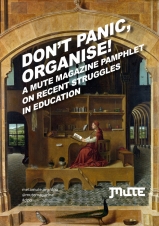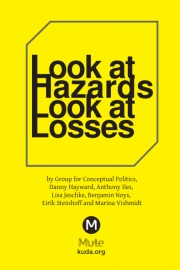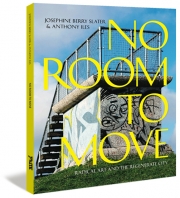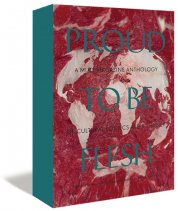I Was an Art Spy for Mute Magazine
The Tate's recent show Exposed constructed a history of photography and voyeurism but left its own role as broker of images and surveyor of audiences unexplored - writes Duncan Reekie
I enter the museum. This place is perfect for an exhibition on surveillance. CCTV cameras watch from every corner, nervous custodians murmur into their radio headsets and everywhere glass and steel mirrors and shimmers. The vast turbine hall is part cathedral, part Nineteen Eighty-Four. I take the escalator up to level four gliding above the busy gift shops and cafe. At the door of the exhibition I can't find my ticket, the attendant shoots me a glance of bored tolerance. I rummage about and find the scrunched up card and pass into the gallery which is all black, white and cosmetic crimson.

Image: Jacob August Riis, Lodgers in a Crowded Bayard Street Tenement - Five Cents a Spot, 1889
Like the fingers on the hand which obscures Garbo's face on the cover of my program, the show is divided into five sections, and comprises about 250 photographs and a dozen video works. Section one deals with street photography and hidden cameras. The first room is dominated by the large-scale colour prints of artist-photographer Philip-Lorca diCorcia; portraits of anonymous New York pedestrians taken surreptitiously with a covert flash system in 2001. They look like movie stills, the texture of their skin sharp against a pitch black night. Did they see the flash? Do they know I'm in the Tate looking at them? Do they mind? Ermo Nussenzweig did. In 2006 he took diCorcia to court over the ownership of his image, he contended that diCorcia had violated his privacy and his religious beliefs as a Hasidic Jew by selling his image in limited edition prints at around $25,000 each. The judge found against Nussenzwieg, ruling that diCorcia's work was not commerce but art and so protected by freedom of speech under the American constitution.i Ermo's not in this exhibition.
I wander into the next chamber, the prints here are monochromes, small and spectral. My fellow gallery-goers are sophisticated, mostly white, mostly social grades A, B and C1. A few tourists and students. I wish I'd worn a clean shirt, their elegance just makes me aware of my own grime. I join the shuffling throng. Along the walls I follow the history of photography's penetration into the unknown territories of the powerless, the destitute and the excluded. As soon as fast portable camera technology developed at the end of the 19th century photographers began to document the life of the streets, factories and slums of the great cities. In the 1890s Jacob August Riis explored the tenements of New York and presented lantern-lit slide shows of his discoveries. Twenty years later Lewis Wickes Hines was hired by the US National Child Labor Committee to expose the misery of children in American industry. Although they were motivated by reformist zeal, the cameras of Riis and Hines are merciless. Their subjects appear stunned by the lens, they are the social dead. In Riis' Lodgers in a Crowded Bayard Street Tenement - Five Cents a Spot, (1889), a shabby den is crowded with soiled bedclothes and anonymous men lying on the floor or propped up against the walls. Only one is awake, he peers over his blanket through the slits of his eyes and out into the Tate Modern. 'What the fuck do you want?' he seems to say.
As technology developed, handheld and concealed cameras made it possible to capture real people unposed in their natural habitat. Walker Evans used a hidden camera to shoot passengers on the subway. Paul Strand and later Ben Shahn and Helen Levitt used a camera with a right angle viewfinder so that they seemed to be looking away from their subjects, who in response look puzzled; they can't understand why anyone would take a picture of an empty street. There are also display cases with early spy ware; a shoe with a camera hidden in the heel, a camera disguised as a pocket watch, a right angle camera. I find myself standing close to a beautiful women with pre-Raphaelite hair, she smells of lemon.
I follow her into the celebrity section. Here's a sequence of the courtesan Countess di Castiglione, who immortalised her own beauty in 700 photographs by Pierre-Louis Pierson, taken over a 40 year period beginning in 1856. Here's Burton and Taylor kissing on a yacht, Marilyn Monroe with the subway vent blowing her dress up and here's Paris Hilton weeping her way to prison. Most striking are the shots by Tazio Secchiaroli, mythical icons from the genesis of the paparazzi. Secchiaroli was an inspiration for the eponymous photojournalist character Paparazzo in Fellini's La Dolce Vita (1960). A photo sequence shot outside a nightclub in Rome 1958 could be straight out of Heat magazine. Blonde movie star Anita Ekberg squints from her car whilst her angry husband chases a photographer, but there's something primordial about it, almost as if they know they're inventing a new game.

Image: Pierre-Louise Pierson, The Countess of Castiglione, c.1863/66
I'm holding up the queue so I shuffle into the next room, into sexual voyeurism. A peepshow of early stereoscopic porn, bondage, transvestites, prostitutes, prints by Weegee, Man Ray, Cartier-Bresson, Robert Frank, Mapplethorpe, Cammie Toloui and Susan Meiselas. But the first image that stops me in my tracks is Chris Verene's colour print 'Untitled', from the series Camera Club ca. (1996). In a bay window framed by classical columns a nude woman poses on a white cloth. You can see only one arm, most of her legs and her vagina. She's wearing black shoes. In the foreground, obscuring the model, with his back to you, is a male photographer taking a shot of her. In the flash every fold of his leisurewear is crisp. He leans into the frame, swivelling on his scuffed loafers, the strap of his bum bag black against his slacks.
I follow music around a corner into a projection space where Nan Goldin's video slideshow The Ballad of Sexual Dependency 1979-2008 is screening. It's half way through so I guess it must loop. In the darkness I fumble onto a vinyl bench brushing someone's leg. Goldin replays her life in voluptuous saturated colour, dead friends, weeping lovers, parents, parties, drag queens, junkies and funerals. But unlike any other images in the exhibition, these portraits don't position the viewer as a nameless voyeur; they put you behind the eyes of Nan Goldin, into the company of her friends. Also unlike any other exhibit, the video has a sign warning about offensive content.
I leave the cinema and enter a dimly lit corridor given over to a sequence of large monochrome prints from Kohei Yoshiyuki's series The Park shot in the early 1970s. Yoshiyuki became fascinated by the Peeping Toms who stalked Tokyo parks at night spying on lovers clinched amongst the lawns and trees. Using an infrared flash he captured both the lovers and the voyeurs as they stole upon their prey. In the most disturbing print a couple entwine unaware that strangers surround them and there is an extra hand in their fondling. For the original exhibition in 1979 the gallery space was blacked out and the audience were given torches to examine the life size prints. Why didn't they do that here?
Next comes violence, a gallery of iconic atrocities from the American Civil War to Rwanda. Executions, starving children, lynchings, suicides, bomb victims and the Holocaust. Ruth Snyder twitches in the electric chair (1928), a Buddhist monk sits serenely as he is consumed by flame (1963), Jackie Kennedy screams in the back of the Lincoln Continental (1964). Once again in Eddie Adams' Pulitzer Prize winning Viet Cong Officer Executed (1968), you can flinch as the bullet enters Nguyen Van Lém's head, the eternal instant of annihilation. Down the street from the killing, like Auden's Musée des Beaux Arts, people are walking, a car passes.
In Marcello Geppetti's monochrome series from the Fire at the Hotel Ambassador (1959) a women is falling from an upper storey window, her white night dress incandescent against the grey evening. You know in seconds she will be dead. Who was she? How does it feel to fall like that? Before she jumped to escape the heat did she look down and see Marcello taking pictures in the street? Further on, in a sequence of prints by Brassaï A Man Dies in the Street (1932) a crowd gathers around a corpse on a rain-wet pavement. In the reflection of the photo frame I watch a young tourist contemplate death.
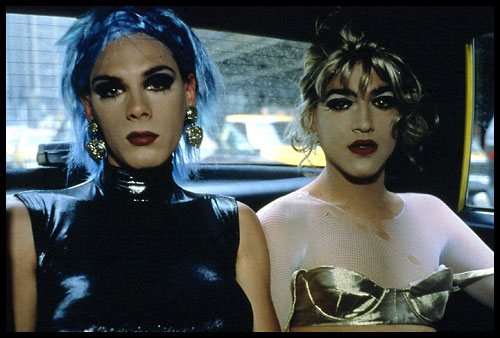
Image: Nan Goldin, Misty and Jimmy Paulette in a Taxi, NYC, 1991
After the stark documents of violence it is Oliver Lutz's provocative installation The Lynching of Leo Frank (2009) that strikes the deepest cut. I'm standing before a black monochrome canvas about 6ft by 4ft. Is this perhaps a Reinhardt or a Rauschenberg ? As I turn to leave I discover a video monitor with a live image of myself attending a lynching. Surrounded by onlookers Leo Frank dangles from a tree, his head at an obscene angle. This shocking montage is produced by a CCTV camera focused on the canvas that frames both the spectator and a photograph hidden under the black paint. In 1915 Frank was the victim of an anti-Semitic vigilante group called the Knights of Mary Phagan which included a former US governor, a superior court judge, a Mayor and several county sheriffs.ii The Knights of Mary Phagan were later instrumental in the revival of the Ku Klux Klan. As was customary at the time, the photograph of Leo Frank's lynching was distributed as a popular postcard.
The final section considers the development of systems and uses of surveillance. There are beautiful almost abstract aircraft reconnaissance shots of missile sites, grainy covert shots of spies and thieves, apocalyptic landscapes of war and eerie cityscapes with multiple CCTV installations. Shai Kremer's Urban Warfare Training Centre, Panorama, Tze'elim, (2007) is a high angle landscape of a mock Muslim Arab town built by the US military in Israel for training US and Israeli troops. Against a lowering sky, the mosques and homes are not yet fully formed, like bad Lego. During training exercises, speakers play the sounds of modern war: helicopters, mortar rounds, Arabic music and the call to prayer.
In the centre of this gallery there is a bank of video monitors with designated headphones. A gallery-goer is watching a video on the monitor but he's not using the headphones... does he realise that he's supposed to? I reach around him and put the headphones on; it's Chip Lord's mischievously subversive Abscam (Framed) (1981). It features the hidden camera footage of an FBI sting operation in which US Congressman Michael 'Ozzie' Meyers accepts a bribe. This footage is intercut with Chip Lord revisiting the same hotel room and re-enacting the scene. Lord' s subversive glee is infectious.
Like the earlier section on sex, there's more art here than photojournalism, there's work by a range of contemporary artists who have initiated projects which critique or interact with the modern panopticon. Merry Alpern spied on women in a New York store changing room, Laurie Long went dating with a concealed camera, Emily Jacir made a photo diary by inserting herself daily into CCTV footage of a city square and Shizuka Yokomizo took shots of strangers through their windows at prearranged times. On the far wall is a selection of prints from Sophie Calle's infamous series The Hotel (1981). Calle got herself a job as a chambermaid in a Venice hotel then searched through the guests' rooms while they were out, photographing their possessions and keeping a journal of her discoveries and emotional responses. Each work is dedicated to a given room featuring a colour shot of the bed, her journal entries and a grid of monochrome shots of the occupants personal effects; shoes, a bin, the inside of a drawer, the contents of a suitcase, a letter.

Image: Kohei Yoshiyuki, from The Park, 1979
I've been in this museum for three hours, my eyes sting. As I make my way to the exit I glance up at the projection of Thomas Demand's Camera (video still, 2007); it's a still colour video image of a CCTV camera up on the wall in some kind of generic institute. I watch it for some while to see if it's going to move... it doesn't. What would have been a whole lot more interesting would have been a live projection of the exhibition space shot from all the real CCTVs in the galleries.
At the end of the exhibition there's an Exposed gift shop selling catalogues, postcards and voyeurism themed merchandise. The postcard selection is very limited; I ask the shop assistant if there are any postcards of the Lynching of Leo Frank. There aren't.
Saturday 18th September 4.07 am
I wake up in a cold sweat my heart pounding; I dreamt Sophie Calle was in my room going through my drawers, searching for Art stuff, taking photos of me asleep. I get to thinking about the exhibition.
Exposed is fascinating and at times deeply moving. But it's also flawed in both content and structure. Any selection as ambitious as this is bound to have omissions, but the holes in this show leave it fragmented, outmoded and disengaged from the media it should be investigating. Essential material is absent: 9/11; Abu Ghraib; the protest video movement; the deaths of Carlo Giuliani and Ian Tomlinson; live web porn; happy slapping; reality TV... these are only the most glaring breaches. This negligence is really bad faith. The show was designed for prestigious public Art museums and so constrained both by the sensibilities of bourgeois taste and the still treacherous boundaries of what can and cannot be consecrated as Art. The curation is erratically eclectic yet restricted to the narrow cultural categories of historic photography, photojournalism and fine Art. To the Tate the inclusion of photojournalism may still seem cutting edge, to your average BTEC Art and Design student it's kind of over. Further, Exposed fails to integrate its aesthetic of invasive looking into the structure of the exhibition experience. Gallery going is such a voyeuristic pleasure anyway, with the resources at the Tate's disposal they could've created a techno mirror-maze of guilt, shame, lust and redemption. Would such flamboyance betray those whose images hang in the galleries? Maybe detached aesthetic objectivity is a crueller betrayal.

Image: Brassaï, A Man Dies in the Street, 1932
10.30 am
I'm in my seat in the velvety red Starr Auditorium. I'm here for an international symposium on violence and representation; an autopsy for Exposed. The auditorium is almost full. The audience is mostly academics and students, at least they look like they are. I'm still trying to figure out the issues at the heart of the exhibition. I know photographs were never true, I know that they were always chemical discolorations made by a complex technical process, indexical texts that were encoded by complicated social, historical and cultural forces. And I know that now digital photography can atomise truth into pixels and recombine them into a new truth. But could you explain that to someone who objected to the image of their dead child being exhibited in an Art gallery? My question is this; by what authority does the Art museum explore the private life and death of the anonymous?
The symposium is introduced by Simon Baker, the Tate's curator of photography and international Art. Baker says the Idea behind the symposium was to draw out one of the least developed strands in the exhibition - violent imagery was problematic in the context of the Tate and there was a process of censorship. He introduces the author and academic Professor John Roberts whose presentation is 'Violence, Photography and the Inhuman'. Roberts' talk is accompanied by a sequence of powerful projected images including work from Jo Spence's series A Picture of Health (1982-1991) and a sequence of portraits of soldiers with horrific war injuries from Ernst Friedrich's notorious book War on War (1919). Friedrich was a revolutionary pacifist who used shocking images in his campaign against capitalist war ideology. Roberts' key point is that photography can be used to strategically short circuit the systemic violence of capitalism, but he doesn't explain how.
Next up is the celebrated Magnum photojournalist Susan Meiselas whose work appears in three of the five sections of the exhibition. She focuses on her print 'Cuesta del Plomo, a well-known site of many assassinations carried out by the National Guard, where people searched daily for missing persons, Managua, Nicaragua', from the series Nicaragua (1981), which is by far the most disturbing image in the show. It's a beautiful colour landscape with exotic green hills rolling down to the sea and distant islands disappearing into the horizon. But in the foreground is half a corpse with its spine sticking out towards you. A dismembered hand and arm lie nearby. Meiselas sees herself as a witness for the victims of violence with a moral and political responsibility to those victims. In the panel discussion that follows, Baker, Roberts and Meiselas debate the commodification of violent imagery. Roberts seems to believe that to counter images of violence the ‘enlightened' spectator must develop an ethical way of looking, as if they could then exempt themself from the vulgar perversions of the sublime. In the Q and A, an audience member points out that the diffusion of images of extreme violence has reached a point of saturation far beyond the limits of Exposed. We are now only ever a mouse click away from a video beheading. Roberts denounces all images of violence that don't enter the political or critical sphere as 'state sponsored nihilism'. I'm a bit confused by this, what are the limits of the critical and political sphere? Surely a key strategy in short circuiting the violence of capitalism is to transgress the given limits of what is deemed critical and political. Moreover, it's the Tate which is state sponsored, with additional contributions from BP, UBS, Unilever and the Hanjin Shipping Co.
![]()
Image: Eddie Adams, Viet Cong Officer Executed, 1968
Saturday 18th 1.00pm
I'm late back from lunch, the intro has started and I creep in.
The afternoon sessions feature an account of arcane conflict in cultural philosophy from Alberto Toscano, a contextualisation of the work of artist Thomas Hirschorn by Julian Stallabrass and a mesmerising slide show by war photographer Simon Norfolk, who describes how, when he realised that modern conflict had become unphotogenic, he turned his camera to the silent and eerie landscapes of the military industrial complex. But what opens up the symposium, from an academic meditation to a passionate critique, is the presence of the Bangladeshi photojournalist and radical activist Shahidul Alam. He begins by focusing on the collaboration of western photojournalists in the violent events they document. Specifically he cites the case of the execution of collaborators that was orchestrated for photojournalists at Poltan Maidan, Bangladesh 1971. Eddie Adams' Viet Cong Officer Executed (1968) was also staged; the killing was moved to the street so that the cameras would have better light.
Alam seeks to be a radical agent in the events he documents, he has methodically used his camera to expose the repression of the Bangladeshi state, for which he has been stabbed and arrested. In March 2010, his Art exhibition Crossfire, which featured the landscapes of extra judicial killings by the security forces, was closed by armed police on its opening night. It opened ten days later after a national storm of protest and a celebrated legal campaign. In the following panel session Alam defends using photography as a shock tactic, he says 'If someone comes to you and says, my house is on fire, do you deconstruct the message or do you help to put it out?'
In the end it comes down to purpose. Since the lantern shows of August Riis, radical photographers have used invasive techniques to expose hidden realities and to subvert the facade of capitalism. This strategy has included not only shock tactics but also the affectionate affirmation of everyday life. But this history cannot be reduced to a heroic myth or an aesthetic; the anonymous, the voiceless and the dead have furnished its images. It is a history of power embedded in colonialism, racism, sexism and classism, and it is not over. A radical strategy does not lie in the grain of the photograph, it is must be reactivated in every curatorial decision in every new context.
The anonymous woman in Geppetti's Fire at the Hotel Ambassador (1959) will always be falling. As an enlightened spectator what will your reaction be? What gives you the right to watch her die? In the book published to accompany the show the principal curator Sandra S.Philips states that:
As photography increasingly becomes a focus in the art museum, and the art museum itself becomes the location for investigating - disinterestedly but authoritatively - the issues of the culture at large, it seems an appropriate moment to look again at these kind of pictures, to learn from them, and to better know ourselves. iii
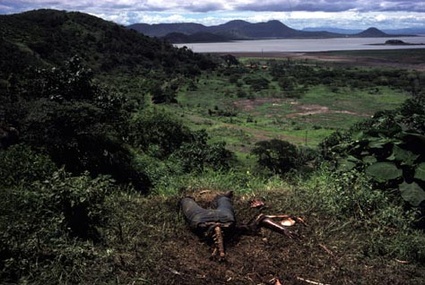
Image: Susan Meiselas, 'Cuesta del Plomo, a well-known site of many assassinations carried out by the National Guard, where people searched daily for missing persons, Managua, Nicaragua', from Nicaragua, 1981
In this context of bourgeois self-improvement can an image of brutal violence short circuit capitalism? If the Art museum is to become a location for investigating ‘the culture at large' it will have to shed the illusion of disinterest and justify its authority. Is the museum to be a force for cultural democracy or a gentrified Police Camera Action!?
No matter what theory tells us, people feel a profound spiritual congruence with their image and the images of those they love. In the digital society anonymity is no longer plausible, everyone has a name. We may not have ownership over our images but we can and should question who is using them and for what purpose. If you want to know who owns the images in the Tate, just try taking a photo in the galleries.
Duncan Reekie is a film maker, performer and author of Subversion : the Definitive History of Underground Cinema, Wallflower Press 2007
Info
Exposed: Voyeurism, Surveillance and the Camera was at Tate Modern 28 May - 3 October 2010. It continues at San Francisco Museum of Modern Art 30 October 2010 - 17 April 2011 Walker Art Centre, Minneapolis 21 May - 11 September 2011
Footnotes
iKirtley, Jane, Giving Offense : When religious beliefs, good taste and freedom of expression collide, American Journalism Review, April/May 2006
ii Alphin, Elaine Marie. An Unspeakable Crime: The Prosecution and Persecution of Leo Frank]. Carolrhoda Books, 2010, p. 117.
iiiPhilips, Sandra S., Exposed : Voyeurism, Surveillance and the Camera, Tate Publishing 2010. p. 15
Mute Books Orders
For Mute Books distribution contact Anagram Books
contact@anagrambooks.com
For online purchases visit anagrambooks.com


